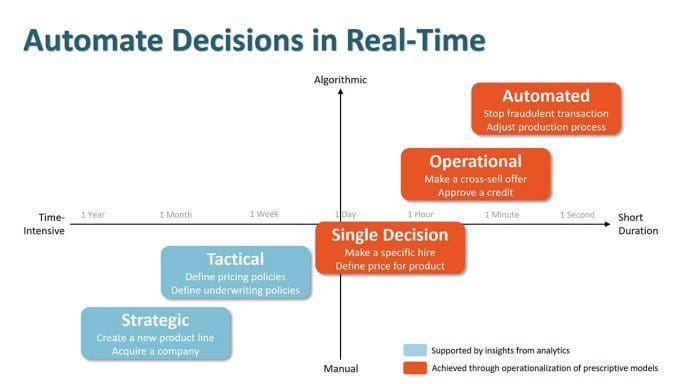 What Artificial Intelligence and Machine Learning Can Do—And What It Can’t
What Artificial Intelligence and Machine Learning Can Do—And What It Can’t
I have seen situations where AI (or at least machine learning) had an incredible impact on a business—I also have seen situations where this was not the case. So, what was the difference?
By Ingo Mierswa, RapidMiner. Sponsored Post.
In my last post, I wrote about Artificial Intelligence (AI). When I last wrote about AI, I focused on the technological side: what is a part of an AI system and what isn’t. However, there is another question which might be more important; what are we doing with AI?
Part of my job is to help investors looking at AI companies with their due diligence. I have discussions with them about companies they might want to invest in. Through this process, I have observed how every company pitch is full of content on how they are using AI to solve a business problem.
Part of me loves this, since some of those companies might be onto something, and I believe every entrepreneur should have a chance. Another part of me thinks of it as a built-in AI “bullshit-meter.” That part of me wants to cringe every time I listen to a founder make something up about how AI will help his company. I have listened to many founders who do not know a lot about AI but know it will help them with funding. Who am I to judge?
I have seen situations where AI (or at least machine learning) had an incredible impact on a business—I also have seen situations where this was not the case. So, what was the difference?
In most of the cases where organizations failed with AI or Machine Learning, they used those techniques in the wrong context. Machine Learning models are not very helpful if you only have one big decision to make. Analytics can still give you easier access to the data you need to make a decision by presenting the data in a consumable fashion. At the end of the day, those single, big decisions are often very strategic. Building a machine learning model or AI to help you make this decision is just not worth the effort. And often it doesn’t yield better results.
Here is where ML and AI can help. Machine Learning and Artificial Intelligence delivers the most value when you need to make lots of similar decisions quickly. Some good examples for this include:
- Defining the price of a product in a market with rapidly changing demands.
- Making offers for cross-selling in a commerce platform.
- Approving or denying a credit application.
- Detecting customers with a high risk for churn and determining the next best action.
- Stopping fraudulent financial transactions.
- …among others
You can see that a human with access to all relevant data could make those decisions—only they can’t without AI or ML, since they would need to make this decision millions of times, every day. Imagine sifting through your customer base of 50 million clients every day to identify those with a high churn risk. That’s impossible for any human, but it’s not a problem at all for a ML model.
So, the biggest value of artificial intelligence and machine learning is to support us in big strategic decisions. Machine learning delivers most value when we operationalize models and automate millions of decisions.
The image below shows the spectrum of decisions and the times humans need to make them. The blue boxes are situations where analytics can help but do not provide the full value. The orange boxes are situations where AI and ML show real value. An interesting observation is that the more decisions you can automate, the higher the value (upper right end of this spectrum).
Fig. 1: Ability to Automate Decisions
One of the best descriptions of this phenomenon comes from Andrew Ng, a well-known researcher in the field of AI. Andrew described what AI can do as follows:
“If a typical person can do a mental task with less than one second of thought, we can probably automate it using AI either now or in the near future.”
I agree with him on this characterization, and I like that he puts emphasis on automation and operationalization of those models, because this is where the biggest value is. The only thing I disagree with is the time unit he chose—it is safe to go with a minute instead of a second.
If you’re looking for more ways that machine learning can help your business, check out my recent webinar How to Ruin Your Business with Data Science and Machine Learning where I talk about how to apply machine learning to your business and show how surprisingly simple it is to draw completely wrong conclusions from statistical models.
Bio: Ingo Miersw, Ph.D. is a founder and President of RapidMiner.

 What Artificial Intelligence and Machine Learning Can Do—And What It Can’t
What Artificial Intelligence and Machine Learning Can Do—And What It Can’t